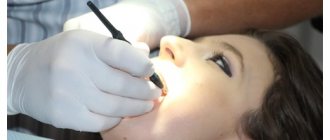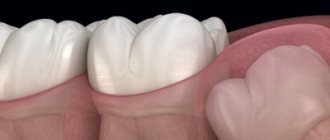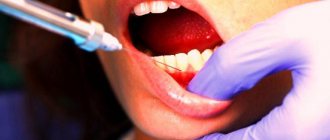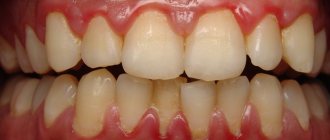The safety of using local anesthesia in the treatment of pregnant women remains an unresolved issue at present. The range of doctors’ opinions is as wide as possible: from “it can be used at any time, it’s absolutely harmless” to “it’s absolutely not allowed during any week, the risk of complications for the mother and child does not justify the benefits of dental treatment.” The reason for this range of judgments is the almost complete lack of evidence for the toxicity/harmlessness of local anesthetics during pregnancy. Pharmacological companies are in no hurry to test their drugs on pregnant women. There is catastrophically little scientific research on this topic. Therefore, significant filtering of information is required. It is not possible to rely on expert opinion, since there are no experts on this problem in the world. Not only in Russia, but also in countries with developed medicine, the issue of using anesthesia (and even the possibility of dental treatment in general) during pregnancy is decided independently by each doctor. There are no strict standards for providing care to pregnant women.
Concerns of doctors and patients
A survey of 702 private dentists in Germany showed that only 61% of them treat pregnant patients, 35.5% postpone treatment until the postpartum period, and 3.5% refer them to other clinics. Only 10% of dentists perform all necessary types of treatment, 14% refuse local anesthesia. Almost half of the dentists indicated that they would not treat in the first trimester, and 8.5% - in the second.1
In a survey of 116 dentists in Connecticut, USA, 97% of dentists said they had treated pregnant women, but only 45% felt comfortable doing so.2
Seeking a consultation with a gynecologist does not clarify the situation much. A survey of 138 obstetricians in North Carolina, USA, found that 49% rarely or never recommend dental examinations to patients.3
Women themselves have little idea of the risks of refusing treatment during pregnancy. In a 2012 survey, two-thirds of Australian women said they did not seek dental care during pregnancy, even if they had problems.4
Is dental treatment necessary during pregnancy?
Changes in oral health and food intake during pregnancy may increase the incidence of dental caries.5 If left untreated, pulpitis and periodontitis may occur. Periodontitis can cause periostitis and more serious complications.
Hormonal changes in pregnant women increase the incidence of gingivitis and periodontitis.6 Untreated periodontitis, according to some studies, increases the risk of low birth weight,7 premature birth, miscarriage and preeclampsia.8
Prompt management of periodontal problems improves the health of not only the mother, but also the newborn.9 Therefore, proper monitoring of oral health during pregnancy and treatment if necessary is recommended.10
Can pregnant women have their teeth treated with anesthesia?
A visit to the dentist is a must when planning a pregnancy. But even if all serious dental problems are eliminated at this stage, the woman is not immune from the development of dental diseases at any stage of pregnancy. The fact is that at this time significant hormonal changes and changes in the functioning of all systems and organs occur in the body. In addition, the pH of saliva changes and a lack of calcium may be felt. Therefore, during pregnancy, problems with teeth and gums often worsen, which can lead to dangerous diseases such as pulpitis and periodontitis. These diseases require mandatory treatment, since their complications can harm the health of the mother and baby.
It is possible to treat teeth with anesthesia during pregnancy. The main thing is to use anesthesia only when it is really necessary, and also to choose the right method and means of pain relief. Remember that a pregnant woman should not endure acute pain. Lack of anesthesia during painful dental procedures can lead to painful shock in a pregnant woman, which is severe stress for the body of the mother and baby.
Common misconceptions about local anesthesia
There is a special anesthesia for pregnant women
No, expectant mothers are given the same anesthesia as everyone else. The same articaine, mepivacaine, lidocaine and novocaine.
Anesthesia during pregnancy can lead to a lower IQ in the child and other cognitive impairments.
This fact was indeed mentioned in the medical literature, but it has nothing to do with local anesthesia used in dentistry. Decreased IQ has been reported in children whose mothers received general anesthesia.11
Previously used anesthetics were dangerous, but modern ones do not penetrate (or almost do not penetrate) through the placental barrier, and therefore are completely harmless. Most often this is stated about articaine (ultracaine).
In fact, articaine also penetrates, like all other anesthetics. But its percentage in the fetal blood is really lower - 32% of the content in the mother’s bloodstream. Lidocaine has a similar figure - 52-58%, mepivacaine - 64%.12 Adrenaline also passes through the placenta and has an effect on the fetus.13
Anesthesia can be given to pregnant women, but only without adrenaline.
For this reason, many dentists use mepivacaine, an anesthetic that does not have a vasodilator effect and is therefore used without a vasoconstrictor. However, its analgesic effect lasts on average only 25-40 minutes.14 This is not enough for most dental procedures. Mepivacaine penetrates the placenta to a greater extent, and at a faster rate (compared to lidocaine and adrenaline). And has a category C according to the FDA classification. This is not the best choice for most women. It is indicated for patients with arterial hypertension, paroxysmal ventricular tachycardia, atrial fibrillation, bronchial asthma and allergies to sulfites (added to the carpule to stabilize adrenaline).
Adrenaline itself also has a category C. But experimental animals were administered astronomical doses of this drug, at which serious teratogenic effects were identified. For example, in 1981, adrenaline at a dosage of 500 mg per kilogram of body weight caused a decrease in reproductive capacity in hamsters.15 For humans, such a horse dose (calculated by weight) is not used even in case of anaphylactic shock or cardiac arrest. A dental carpule contains 0.009 mg or 0.018 mg of adrenaline; more than 7-8 carpules cannot be done at one time, and the mass of even the most graceful lady is many times greater than the mass of a hamster.
Theoretically, it has been suggested that the vasoconstrictor may cause fetal hypoxia by reducing uteroplacental blood flow. In an experiment on sheep, a decrease in fetal blood flow for several minutes was noted.16 But to date there has been no evidence of a negative effect on the human fetus.
In addition, it should be recalled that adrenaline is the body’s own hormone; it is present in the bloodstream regardless of whether it was exogenously administered or not. And the endogenous hormone is intensely released just in case of pain, fear, panic. That is, when weak, adrenaline-free anesthesia does not provide sufficient pain relief.
Adrenaline increases the tone of the uterus and can lead to miscarriage or premature birth.
This is such a common misconception that it is worth explaining the situation in detail. Adrenaline activates both alpha receptors of the uterus (increasing tone) and beta receptors (decreasing tone). So its effect on β2-adrenergic receptors is predominant. Adrenaline reduces uterine tone.17 Moreover, with epidural anesthesia during labor itself, adrenaline is contraindicated because it causes atony and inhibits the second stage. Miscarriages during dental treatment under local anesthesia have not yet been encountered anywhere in the world (or at least there is not a single mention of this in the professional literature).
Previously, not only adrenaline, but also norepinephrine was added to the anesthetic solution. Now it has been completely abandoned. So norepinephrine activated α-adrenergic receptors more and increased uterine tone. Perhaps this is where such a misconception originated.
Local anesthesia during pregnancy is absolutely harmless (if performed correctly).
For a long time, indeed, no convincing evidence of any special teratogenic or toxic effects on the child and mother was found. Studies on this issue have been sporadic and with a small sample. But in 2015, the results of a study conducted in Israel back in 1999-2005 of 210 pregnant women whose dental treatment was performed under local anesthesia were published. They were compared with 794 pregnant women who did not undergo the procedure. The frequency of anomalies in children of the first group was 4.8%, the second – 3.3%. The authors considered the difference to be insignificant and concluded that the use of dental local anesthetics, as well as dental treatment during pregnancy, does not pose a significant teratogenic risk.18 Subsequent authors in articles devoted to this problem began to use this conclusion as further evidence of the safety of local anesthesia.
However, this conclusion raised objections among other experts.19 Not everyone thought the 1.5% difference was insignificant. After all, if the percentage of anomalies had crossed the 5% barrier even slightly, and according to statistical analysis, the conclusion would have to be changed to the exact opposite - local anesthesia significantly increases teratogenic risks.
In my opinion, 1.5% is still a significant increase in risk. But every expectant mother has the right to decide this for herself; the dentist should not impose his own opinion on her.
Is dental treatment done during pregnancy?
Pregnancy is associated with changes throughout the body, including the oral cavity. Hormonal changes increase the likelihood of gum disease and other dental problems. Therefore, during pregnancy, it is advisable to regularly visit the dentist for examination and professional oral hygiene.
Proper hygiene of teeth and gums is one thing. Is it possible to have teeth removed during pregnancy? Modern medicine confirms that yes.
Outdated views
Concerns about dental extractions and treatment during pregnancy stem from outdated beliefs. Many dentists were previously taught that it was unsafe to treat pregnant women. Therefore, dentists often refused such patients the necessary care, regardless of the severity of the problem.
Local anesthesia and other safe treatments _
Is dental treatment done during pregnancy? Current evidence suggests that tooth extractions and other dental procedures are safe during pregnancy. Publications by experts confirm the safety of local anesthesia and painkillers during pregnancy. Obstetricians and gynecologists recommend that expectant mothers undergo routine dental examinations and be sure to seek medical help when needed.
The Journal of the American Dental Association (JADA) published the results of a study that examined the effects of local anesthesia on pregnancy and the fetus. A group of 210 pregnant women underwent dental treatment under local anesthesia. The comparison was made with a control group of 794 women who did not receive local anesthesia. The study found no association between dental procedures using local anesthetics and an increased risk of major medical conditions in newborns. The study authors found no difference between the rate of miscarriage, birth weight, or fetal age at delivery in the two groups.
Are other types of anesthesia allowed?
Modern local anesthetics are safe for mother and child. Are more intense types of anesthesia acceptable? During pregnancy, general anesthesia, sedation with nitrous oxide (N2O), as well as diazepam and its analogues are contraindicated. However, some types of sedation or general anesthesia are still used after consultation with an obstetrician-gynecologist.
When to remove a tooth?
If tooth extraction is unavoidable during pregnancy, it is important to choose the right time. It is best to have dental procedures done during the second trimester and delay non-urgent procedures until after birth.
During your third trimester, you may find it uncomfortable to lie in a chair and lean back while your dentist removes a tooth. Dental treatment is permitted during the first trimester, and pregnant women in the JADA study received local anesthesia during the first trimester.
Of course, for urgent reasons, dental care is provided in any trimester. An inflammatory process or dental injury requires urgent dental intervention. This is better for you and your baby than leaving an infection in your mouth.
Take care of your health and the health of your child, do not neglect the condition of your teeth and gums during pregnancy. Go through all the necessary procedures, be it tooth extraction, root canal treatment or just professional hygiene. If you haven't been to the dentist for a long time, make an appointment without delay. Between visits, practice good oral hygiene to keep your teeth and gums healthy.
How to choose the optimal anesthetic?
1. First, you need to decide whether pain relief is really necessary. Many dental procedures are painless or slightly painful. Professional teeth cleaning, treatment and prosthetics of pulpless teeth, in some cases, treatment of caries or wedge-shaped defects in living teeth are unpleasant, but often it is quite possible to endure them without experiencing unbearable suffering. Therefore, it is recommended to try this safest approach. If serious pain occurs, there is no need to torture yourself - it is wiser to agree to local anesthesia.
Cosmetic procedures (teeth whitening, installation of veneers) are completely inappropriate during pregnancy - they can and should be postponed.
2. From the entire range of anesthetics, in the absence of contraindications, it is preferable to choose 4% articaine with adrenaline 1:200,000. Articaine, although it has category C according to the FDA classification, is safer than other anesthetics. Its teratogenic effect was discovered when laboratory rabbits and rats were given loading doses of 4% articaine in combination with 1:100,000 adrenaline (2-4 times the maximum permissible concentration for humans). When using drugs at the level of the maximum permissible concentration for humans, no teratogenic effect was detected in experimental animals.20 Moreover, the concentration of 1:200,000 is half as low, and no one will use 7 carpules at a time (the maximum permissible volume) in pregnant women.
3. If such anesthesia turns out to be ineffective, then it is better to use the second carpule with a ratio of 1:100,000 articaine and adrenaline. The chances of achieving deep pain relief are significantly increased.
4. If adrenaline is completely contraindicated or significantly increases the risk of complications (arterial hypertension, paroxysmal ventricular tachycardia, atrial fibrillation, bronchial asthma, hyperthyroidism, pheochromocytoma, etc.), then you need to use 3% mepivacaine without adrenaline.
5. It is acceptable to use lidocaine with an adrenaline concentration of 1:200,000 or 1:100,000 for pregnant women. Lidocaine has category B. However, the effectiveness of its anesthesia is 1.5 times less than that of articaine.21 And the risk of allergic reactions is higher (up to to anaphylactic shock).
conclusions
- Anesthesia can be given to pregnant women. And it is necessary (if required).
- There is no special anesthetic for pregnant women.
- Some stories about the dangers of anesthesia refer to general anesthesia, not local anesthesia (and there is still a lot of uncertainty there).
- Modern anesthetics are better than the old ones, but they are not completely harmless.
- Anesthesia with adrenaline can be done, and in most cases it is even desirable.
- Adrenaline reduces the tone of the uterus; there have been no miscarriages caused by local anesthesia.
- Local anesthesia in dentistry is not completely safe. It is necessary to balance between the expected benefits and possible risks.
- Of the drugs, 4% articaine with an adrenaline concentration of 1:200,000 is preferable.
- You can also use articaine with an adrenaline concentration of 1:100,000, mepivacaine without adrenaline, lidocaine with adrenaline.
What painkillers can be used during pregnancy?
The use of general anesthesia is strictly contraindicated for pregnant women. During pregnancy, only local anesthesia is allowed. You can give painkilling injections in the following cases:
- With the correct selection of anesthetic and the absence of individual intolerance or allergies to the components of the drug.
- In the absence of adrenaline in the composition of the drug. Many anesthetics contain adrenaline, which leads to vasoconstriction. An increase in the concentration of adrenaline in a pregnant woman can lead to an increase in uterine tone and the risk of premature onset of labor.
- It is not recommended to give pain-relieving injections using Lidocaine. This drug is absorbed quite well and can easily penetrate the placenta into the child’s body.
Some of the safest painkillers used by dentists when treating the teeth of pregnant women are the drugs Ultracaine and Primacaine. These are special anesthetics that do not contain adrenaline and are not absorbed into the placenta, therefore they pose minimal risk to the baby’s health. There are other safe means. An experienced dentist will be able to select a drug depending on the individual characteristics of the patient.
If a pregnant woman is afraid of pain-relieving injections, you can pre-treat the gum area with a special gel.
Literature
- Pistorius J, Kraft J, Willershausen B. Dental treatment concepts for pregnant patients – results of a survey. Eur J Med Res. 2003 Jun 30; 8(6):241-6.
- Pina PM, Douglass J. Practices and opinions of Connecticut general dentists regarding dental treatment during pregnancy. Gen Dent. 2011 Jan-Feb; 59(1):e25-31.
- Wilder R, Robinson C, Jared HL, Lieff S, Boggess K. Obstetricians' knowledge and practice behaviors concerning periodontal health and preterm delivery and low birth weight. J Dent Hyg. 2007 Fall; 81(4):81.
- George A, Shamim S, Johnson M, Dahlen H, Ajwani S, Bhole S, Yeo AE. How do dental and prenatal care practitioners perceive dental care during pregnancy? Current evidence and implications. Birth. 2012 Sep;39(3):238-47
- Kidd E, Fejerskov O. Essentials of dental caries. 3rd ed. Oxford: Oxford University Press; 2005. pp. 88–108.
- Amini H, Casimassimo PS. Prenatal dental care: A review. Gen Dent. 2010; 58:176–18
- Vergnes JN, Sixou M. Preterm low birth weight and maternal periodontal status: A meta-analysis. Am J Obstet Gynecol. 2007; 196:135.e1–135.e7.
- Xiong X, Buekens P, Fraser WD, Beck J, Offenbacher S. Periodontal disease and adverse pregnancy outcomes: a systematic review. BJOG. Feb 2006; 113(2):135-43.
- López NJ, Da Silva I, Ipinza J, Gutiérrez J. Periodontal therapy reduces the rate of preterm low birth weight in women with pregnancy-associated gingivitis. J Periodontol. 2005;76(11 Suppl):2144–53.
- Lee JM, Shin TJ. Use of local anesthetics for dental treatment during pregnancy; safety for parturient. J Dent Anesth Pain Med. 2017 Jun; 17(2):81-90. Translation of this article into Russian: Use of local anesthetics for dental treatment during pregnancy; safety for women in labor.
- Yu CK, Yuen VM, Wong GT, Irwin MG. The effects of anesthesia on the developing brain: a summary of the clinical evidence. F1000Res. 2013 Aug 2;2:166.
- Strasser K, Huch A, Huch R, Uihein M. Placental transfer of carticaine (Ultracain) a new local anesthetic agent. Z Geburtshilfe Perinatol. 1977 Apr; 181(2):118-20.
- Morgan CD, Sandler M, Panigel M. Placental transfer of catecholamines in vitro and in vivo. Am J Obstet Gynecol 1972; 112:1068–75.
- Haas A. An update on local anesthetics in dentistry. J Can Dent Assoc. 2002 Oct; 68(9):546-51.
- Hirsch KS, Fritz HI. Teratogenic effects of mescaline, epinephrine, and norepinephrine in the hamster. Teratology. 1981 Jun; 23(3):287-91.
- Hood DD, Dewan DM, James FM., 3rd Maternal and fetal effects of epinephrine in gravid ewes. Anesthesiology. 1986; 64:610–613.
- Mike Samuels, Nancy Samuels. New Well Pregnancy Book: Completely Revised and Updated. 1996
- Hagai A, Diav-Citrin O, Shechtman S, Ornoy A. Pregnancy outcome after in utero exposure to local anesthetics as part of dental treatment: A prospective comparative cohort study. J Am Dent Assoc. 2015 Aug; 146(8):572-580.
- Best AM. More on local anesthetics in pregnancy. J Am Dent Assoc. Dec 2015; 146(12):868-9.
- https://www.drugs.com/pro/articaine-and-epinephrine-injection.html
- Malamed SF. Handbook of local anesthesia. 4th ed. St. Louis, Mosby; 1997.









